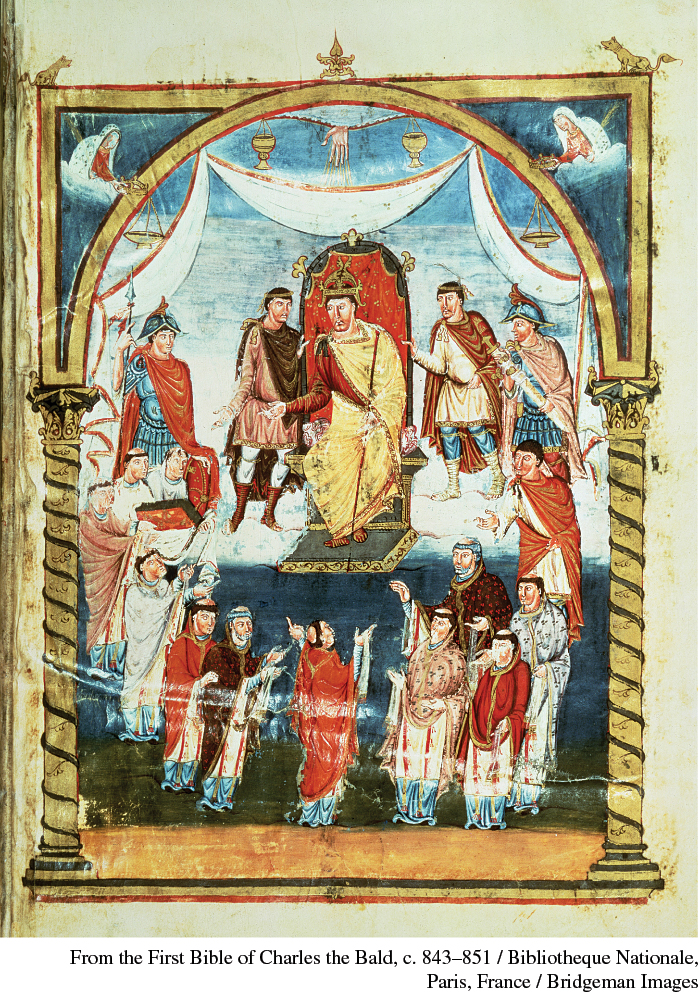Introduction for Chapter 9

IN 841, A FIFTEEN-YEAR-OLD BOY named William went to serve at the court of Charles the Bald, king of the Franks. William’s father, Bernard, was an extremely powerful noble. His mother, Dhuoda, was a well-educated, pious, and able woman; she administered the family’s estates in the south of France while her husband was occupied with politics at court. In 841, however, politics had become a dangerous business. King Charles was fighting with his brothers over his portion of the Frankish Empire, and he doubted Bernard’s loyalty. In fact, William was sent to Charles’s court as a kind of hostage, to ensure Bernard’s fidelity. Anxious about her son, Dhuoda wrote a handbook of advice for William, outlining his moral obligations. She emphasized duty to his father even over loyalty to the king:
Royal and imperial . . . power seem preeminent in the world, and the custom of men is to [put] their names ahead of all others. . . . But despite all this, I caution you to render first to him whose son you are special, faithful, steadfast loyalty as long as you shall live. . . . So I urge you . . . that first of all you love God. . . . Then love, fear, and cherish your father.
William heeded his mother’s words, with tragic results: when Bernard ran afoul of Charles and was executed, William died in a failed attempt to avenge his father.
Dhuoda’s handbook reveals the volatile political atmosphere of the mid-ninth century, and her advice to her son points to one of its causes: a crisis of loyalty. Loyalty to emperors, caliphs, and kings competed with allegiances to local authorities, which, in turn, vied with family loyalties. The period from 600 to 750 had seen the startling rise of Islam, the whittling away of Byzantium, and the beginnings of stable political and economic development in an impoverished Europe. The period from 750 to 1050 would see all three societies contend with internal issues of diversity even as they became increasingly conscious of their unity and uniqueness. At the beginning of this period, rulers built up and dominated strong, united political communities. By the end, these realms had fragmented into smaller, more local units.
In Byzantium, military triumphs brought emperors enormous prestige. A renaissance (French for “rebirth”)—that is, an important revival—of culture and art took place at Constantinople. Yet at the same time new elites began to dominate the Byzantine countryside. In the Islamic world, a dynastic revolution in 750 ousted the Umayyads from the caliphate and replaced them with a new family, the Abbasids. The Abbasid caliphs moved their capital to the east, from Damascus to Baghdad. Even though the Abbasids’ power began to ebb as regional Islamic rulers came to the fore, the Islamic world, too, saw a renaissance. In western Europe, Charlemagne—a Frankish king from a new dynasty, the Carolingians—forged a huge empire and presided over yet another cultural renaissance. Yet this newly unified kingdom was fragile, disintegrating within a generation of Charlemagne’s death. In western Europe, even more than in the Byzantine and Islamic worlds, power fell into the hands of local lords.
CHAPTER FOCUS What forces led to the dissolution—or weakening—of centralized governments in the period from 750 to 1050, and what institutions took their place?
Along the borders of these realms, new political entities began to develop, shaped by the religion and culture of their more dominant neighbors. Rus, the ancestor of Russia, grew up in the shadow of Byzantium, as did Bulgaria and Serbia. Western Europe cast its influence over central European states. In the west, the borders of the Islamic world remained stable or were pushed back. By the year 1050, the contours of what were to become modern Europe and the Middle East were dimly visible.